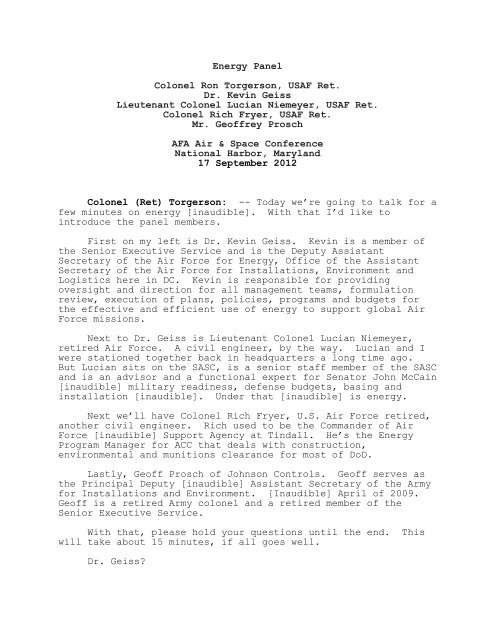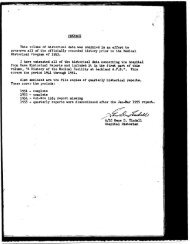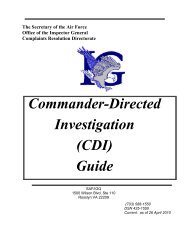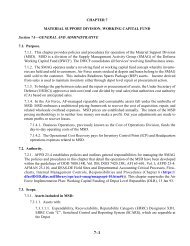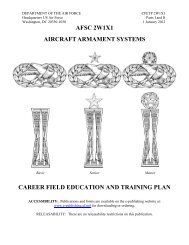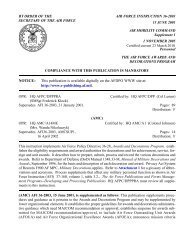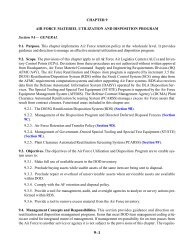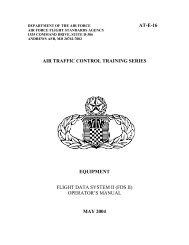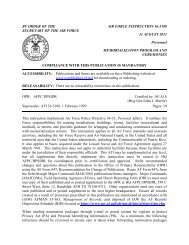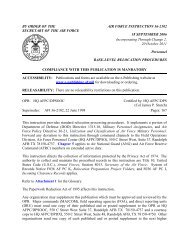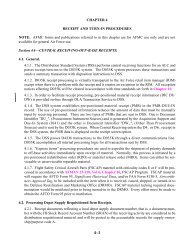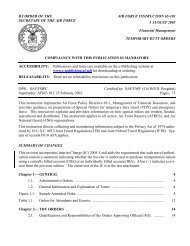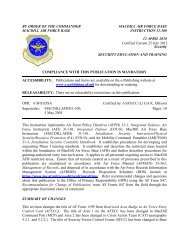Energy Panel Colonel Ron Torgerson, USAF Ret. Dr ... - Air Force Link
Energy Panel Colonel Ron Torgerson, USAF Ret. Dr ... - Air Force Link
Energy Panel Colonel Ron Torgerson, USAF Ret. Dr ... - Air Force Link
You also want an ePaper? Increase the reach of your titles
YUMPU automatically turns print PDFs into web optimized ePapers that Google loves.
<strong>Energy</strong> <strong>Panel</strong><br />
<strong>Colonel</strong> <strong>Ron</strong> <strong>Torgerson</strong>, <strong>USAF</strong> <strong>Ret</strong>.<br />
<strong>Dr</strong>. Kevin Geiss<br />
Lieutenant <strong>Colonel</strong> Lucian Niemeyer, <strong>USAF</strong> <strong>Ret</strong>.<br />
<strong>Colonel</strong> Rich Fryer, <strong>USAF</strong> <strong>Ret</strong>.<br />
Mr. Geoffrey Prosch<br />
AFA <strong>Air</strong> & Space Conference<br />
National Harbor, Maryland<br />
17 September 2012<br />
<strong>Colonel</strong> (<strong>Ret</strong>) <strong>Torgerson</strong>: -- Today we’re going to talk for a<br />
few minutes on energy [inaudible]. With that I’d like to<br />
introduce the panel members.<br />
First on my left is <strong>Dr</strong>. Kevin Geiss. Kevin is a member of<br />
the Senior Executive Service and is the Deputy Assistant<br />
Secretary of the <strong>Air</strong> <strong>Force</strong> for <strong>Energy</strong>, Office of the Assistant<br />
Secretary of the <strong>Air</strong> <strong>Force</strong> for Installations, Environment and<br />
Logistics here in DC. Kevin is responsible for providing<br />
oversight and direction for all management teams, formulation<br />
review, execution of plans, policies, programs and budgets for<br />
the effective and efficient use of energy to support global <strong>Air</strong><br />
<strong>Force</strong> missions.<br />
Next to <strong>Dr</strong>. Geiss is Lieutenant <strong>Colonel</strong> Lucian Niemeyer,<br />
retired <strong>Air</strong> <strong>Force</strong>. A civil engineer, by the way. Lucian and I<br />
were stationed together back in headquarters a long time ago.<br />
But Lucian sits on the SASC, is a senior staff member of the SASC<br />
and is an advisor and a functional expert for Senator John McCain<br />
[inaudible] military readiness, defense budgets, basing and<br />
installation [inaudible]. Under that [inaudible] is energy.<br />
Next we’ll have <strong>Colonel</strong> Rich Fryer, U.S. <strong>Air</strong> <strong>Force</strong> retired,<br />
another civil engineer. Rich used to be the Commander of <strong>Air</strong><br />
<strong>Force</strong> [inaudible] Support Agency at Tindall. He’s the <strong>Energy</strong><br />
Program Manager for ACC that deals with construction,<br />
environmental and munitions clearance for most of DoD.<br />
Lastly, Geoff Prosch of Johnson Controls. Geoff serves as<br />
the Principal Deputy [inaudible] Assistant Secretary of the Army<br />
for Installations and Environment. [Inaudible] April of 2009.<br />
Geoff is a retired Army colonel and a retired member of the<br />
Senior Executive Service.<br />
With that, please hold your questions until the end. This<br />
will take about 15 minutes, if all goes well.<br />
<strong>Dr</strong>. Geiss?
<strong>Energy</strong> <strong>Panel</strong> - AFA - 9/17/12<br />
<strong>Dr</strong>. Geiss: Good afternoon. How’s everybody doing?<br />
Audience: Great.<br />
<strong>Dr</strong>. Geiss: Thanks for coming down this afternoon.<br />
Thanks, <strong>Ron</strong>. I look around the table here and I guess I’m<br />
the over-achiever because I never made it past E5, and all these<br />
retired colonels -- [inaudible]. But I’m glad to be here. <strong>Ron</strong><br />
put this together last year, and thank you all for taking the<br />
time to come out here today.<br />
<strong>Energy</strong> is important for every mission of the <strong>Air</strong> <strong>Force</strong>. We<br />
don’t care about energy for energy’s sake, we care about energy<br />
and how it enables the mission of the <strong>Air</strong> <strong>Force</strong>, and that’s to<br />
fly, fight and win in air, space and cyberspace. So everything<br />
that we do in my office and working with the folks around the <strong>Air</strong><br />
<strong>Force</strong> is about that mission assurance. Making sure that we can<br />
do that job around the globe every single day. Whether it’s from<br />
our bases from which we deploy in an expeditionary fashion; or as<br />
we operate our aircraft around the world of mobility aircraft,<br />
combat aircraft, as we train our pilots all around the world,<br />
energy is required for all of that.<br />
I used to joke about some of the folks in my office. They<br />
couldn’t even type up their great thoughts with their computer --<br />
they didn’t have electrons coming out of the wall. So everything<br />
really does touch everything that we do.<br />
The <strong>Air</strong> <strong>Force</strong> is the largest energy consumer in the<br />
Department of Defense. We spend about $9 billion a year on<br />
energy, and that’s both for aviation fuel as well as our<br />
facilities. Our facilities are about a billion dollars; our<br />
aviation fuel is about $8 billion. You could buy a small air<br />
force for that price.<br />
So when you think about that cost in the <strong>Air</strong> <strong>Force</strong> budget,<br />
it’s really something that we want to have a group of folks<br />
paying attention to every day, not only in order to get those<br />
costs down but also thinking about how we can be more effective<br />
and efficient in our operations around the globe.<br />
Every dollar that we don’t spend on energy is a dollar that<br />
we can spend on other priorities for the <strong>Air</strong> <strong>Force</strong>. And as we<br />
look towards the fiscal climate that we’re in and into the<br />
future, it’s very important for us to look for opportunities to<br />
get those costs down and be more effective and efficient in what<br />
we do.<br />
- 2 -
<strong>Energy</strong> <strong>Panel</strong> - AFA - 9/17/12<br />
But it’s not just our cost, it’s also about capability. I<br />
think some of the technologies that are coming out of the fight<br />
will enable us not only to reduce our costs but enhance and<br />
increase our capabilities as we operate around the globe.<br />
What I show on this slide is one of the challenges that we<br />
experience and that’s the volatility in fuel prices. The blue<br />
bars that you see are the prices that we use as planning factors<br />
when we put together the budget about two years before the year<br />
of execution. You can see what comes in that year, the yellow or<br />
orange bar, is quite a bit higher, has been quite a bit higher in<br />
past years as compared to our planning factors.<br />
What this results in is we have to go and find money<br />
elsewhere in the <strong>Air</strong> <strong>Force</strong> budget to help meet this price of the<br />
cost of fuel in that year of execution.<br />
To address the energy challenge that we have in the <strong>Air</strong><br />
<strong>Force</strong> we’re looking to reduce demand, decrease expense, also to<br />
change the culture of the <strong>Air</strong> <strong>Force</strong> to make energy a<br />
consideration in all we do.<br />
As far as our progress in the <strong>Air</strong> <strong>Force</strong>, our energy<br />
essentially is down about 16 percent. We’re pushing sustainable<br />
designs in buildings. In our infrastructure we currently have 35<br />
facilities [inaudible] certified. On that note, one of our<br />
measures is cost. So it’s very important for us as we look at<br />
how we design our buildings that [inaudible] energy efficiency of<br />
those buildings and the buildings will help us decrease the<br />
overall operating cost in the future. It’s not just about<br />
getting that plaque on the side that identifies whether it’s<br />
[lead] certified, but how that can impact our ability to develop<br />
and build more efficient buildings in the future.<br />
We’re investing about $250 million a year specifically on<br />
energy efficiency. This is something we call the energy focus<br />
fund that was put in place two years ago, and we maintain that in<br />
the budget. We have seen a significant impact of those<br />
investments. We calculate that this year alone we have avoided<br />
$500 million in energy costs for our facilities because of those<br />
investments. Since we started making those investments we<br />
calculate about a billion dollars of costs that we’ve avoided<br />
because of those investments in that energy focus fund. So we<br />
see a real return on investment in the energy focus fund.<br />
We’re also looking to reduce our square footage. Buildings<br />
that we now don’t need, and looking at our expanded footprint in<br />
new buildings that are more energy efficient, and get rid of the<br />
old square footage that is less efficient. We have a demolition<br />
focus fund that’s helping us reduce that square footage.<br />
- 3 -
<strong>Energy</strong> <strong>Panel</strong> - AFA - 9/17/12<br />
A week or two ago we awarded the latest contracts for<br />
metering our facilities across the <strong>Air</strong> <strong>Force</strong>, so we’re looking to<br />
not only meet the requirements and legislation to do that<br />
metering, but also get at some of our broader portfolio of our<br />
facilities. It’s hard to manage and have an impact on a facility<br />
that you’re not measuring them to identify what your consumption<br />
is and what the improvements are.<br />
We’re also looking to expand our ESPC program. Just a few<br />
weeks ago you may have seen the sign of our latest ESPC out at<br />
Tinker. $80 million ESPC. So I would say to the business<br />
community out there that the <strong>Air</strong> <strong>Force</strong> is certainly back as it<br />
relates to ESPCs. Those of you that are familiar with our<br />
history and our past, we’re certainly looking forward to<br />
expanding that business here in the future.<br />
Increased supply or expanded supply, the goal that we have<br />
in the <strong>Air</strong> <strong>Force</strong>. We currently have six percent of our total<br />
electricity that comes from renewable alternative sources in<br />
FY11. That’s 131 projects across 56 installations giving us 37<br />
megawatts of total production.<br />
One of these projects, actually there was an article<br />
published this morning, is up at Massachusetts Military<br />
Reservation. It’s a project that we partnered with the Army on,<br />
and there are a few wind turbines up there which support the<br />
environmental restoration that’s going on at MMR. And as of<br />
right now the projections are that those wind turbines are saving<br />
the <strong>Air</strong> <strong>Force</strong> one million dollars a year in electricity costs.<br />
So after they’re done paying for themselves in about 10 or 11<br />
years, they will be free electricity to the <strong>Air</strong> <strong>Force</strong> every year<br />
beyond that.<br />
We also have six enhanced use leases that we’re pursuing to<br />
give us between 500 and 600 megawatts. That’s another<br />
opportunity where we can partner with the private sector, partner<br />
with utilities, help to provide not only power for our<br />
installations but also power that can be exported and used off<br />
the installation.<br />
The final of our three goals is culture change, and assuring<br />
that we’re making energy a consideration in all that we do.<br />
October is <strong>Energy</strong> Action Month, Federal <strong>Energy</strong> Action Month.<br />
We in the <strong>Air</strong> <strong>Force</strong> have a game plan to help get the word out<br />
about energy and trying to break it down to the level of each<br />
individual <strong>Air</strong>man, to try and help him or her identify how they<br />
can have an impact on energy within their particular job<br />
specialty.<br />
- 4 -
<strong>Energy</strong> <strong>Panel</strong> - AFA - 9/17/12<br />
I work with <strong>Air</strong> Education and Training Command, Lieutenant<br />
General Owens. We currently have a program, we’re looking at<br />
every single training program within the <strong>Air</strong> <strong>Force</strong>, across all<br />
curricula, all [inaudible], to identify how we can specifically<br />
address energy within each job. So that whether you’re a<br />
maintainer, an admin assistant, force protection, security<br />
officer, that we can identify exactly how you can have an impact<br />
in your job at the bases to impact energy consumption efficiency.<br />
So our motto, our theme for this coming year starting in<br />
October is [High] on <strong>Air</strong> <strong>Force</strong> <strong>Energy</strong>. We chose that name<br />
because we’re really focusing on how the individual <strong>Air</strong>man can<br />
address energy within their own job, in their position.<br />
It’s also an opportunity for us to focus on the successes<br />
that our <strong>Air</strong>men have had across the <strong>Air</strong> <strong>Force</strong>. This year the <strong>Air</strong><br />
<strong>Force</strong> will be the recipient of six federal energy management<br />
program awards. One of those is Captain Reid Touchberry who is<br />
at Misawa <strong>Air</strong> Base in Japan. Part of his heroic efforts after<br />
the earthquake and tsunami in enabling that installation to<br />
recover and be able to accomplish their mission in light of all<br />
the challenges that they had with loss of power. So it’s just an<br />
example of how our <strong>Air</strong>men apply innovative practices to ensure<br />
that we as an <strong>Air</strong> <strong>Force</strong> can accomplish our daily mission.<br />
Those are the only comments I have at this time. I look<br />
forward to your questions in a few minutes. Thank you.<br />
Lieutenant <strong>Colonel</strong> (<strong>Ret</strong>) Niemeyer: I’m Lucian Niemeyer, I<br />
work [inaudible] for about ten years. [Inaudible] as the years<br />
go by and more competent people drop off so [inaudible].<br />
I’ve been working energy programs for about four years and I<br />
just wanted to provide you a brief synopsis of where we’re at and<br />
where we’re coming from a [inaudible] perspective, particularly<br />
on trying to work with the Department of Defense on identifying<br />
[goals] for energy consumption [inaudible].<br />
We established a chapter in Title 10 related to energy<br />
consumption, energy conservation goals within the Department of<br />
Defense and actually [inaudible] on the facility side of the<br />
house.<br />
Real quick review here. I want to get on to what we’re<br />
looking at in ’12, the Defense Authorization Bill that we just<br />
passed, as well as [inaudible] FY13.<br />
For the most part we’ve got a series of priorities that we<br />
try to look at each year, the committee maintains [inaudible]<br />
- 5 -
<strong>Energy</strong> <strong>Panel</strong> - AFA - 9/17/12<br />
with the House. The most important for us is to do what we can<br />
to encourage all the services to act upon energy efficiency<br />
initiatives to reduce costs. What we’re really looking for most<br />
of all is to provide [inaudible] that have the most direct impact<br />
on the warfighter, whether it be more efficient engines, whether<br />
it be more efficient facilities. We really look at any dollar<br />
saved in energy is a dollar we can provide somewhere else in the<br />
fight.<br />
In the process you’ll see normally us working on provisions<br />
that allow for the services to provide in some cases a<br />
prescriptive approach to allow [inaudible] benchmark of your<br />
consumption, energy metering, things like that, to provide a<br />
better understanding of what we’re consuming in order to direct<br />
efforts to where we can save.<br />
As far as the overall emphasis, particularly on our<br />
committee over the past couple of years, is really focusing<br />
investments on where there’s the most direct impact to either<br />
conserving fuel [inaudible] or return on investments where you<br />
can see a real dollar savings over a short period of time.<br />
There’s been some recent controversy regarding some of the<br />
actions on the part of Congress, particularly by the Senate, as<br />
far as what we’ve put in the FY13 bill, the use of particularly<br />
biofuels and DoD invested in some biofuels. There’s some concern<br />
out there that, those of you who follow Congress, and I don’t<br />
encourage that, but those of you who follow Congress know that<br />
the Senate has passed some language that seeks to ensure that the<br />
money that we’ve spent, particularly in operations and<br />
maintenance, goes towards real readiness requirements and the<br />
funding that’s used for developing or expanding the [inaudible]<br />
is funded with [RDC] accounts. There’s been some back and forth<br />
between the Secretary of the Navy. The committee has some<br />
concerns with what the Secretary of the Navy spent on the Green<br />
Fleet in [inaudible] a few months ago, and it’s caused us to<br />
relook what the services are doing, and to make sure that we’re<br />
not going overboard [inaudible] with some of our [inaudible]<br />
investments, and focusing really on the initiatives that have the<br />
most, and the most apparent and most near term payback<br />
[inaudible].<br />
I think that’s pretty much all I want to talk about. I want<br />
to leave time for questions. But I also want to say I do believe<br />
that from a congressional perspective the <strong>Air</strong> <strong>Force</strong> program seems<br />
to be more prudent [inaudible] to encourage, and that is to<br />
develop technologies, develop initiatives that can save lives on<br />
the battlefield, reduce energy consumption, fuel consumption in<br />
engines, and make ourselves more efficient and more effective<br />
over the long run.<br />
- 6 -
<strong>Energy</strong> <strong>Panel</strong> - AFA - 9/17/12<br />
<strong>Colonel</strong> (<strong>Ret</strong>) Fryer: Thanks, <strong>Ron</strong>, for inviting me back.<br />
Last year I talked a little bit about what I saw from the<br />
outside, [inaudible] perspective, what the <strong>Air</strong> <strong>Force</strong> is doing,<br />
commented, I thought the <strong>Air</strong> <strong>Force</strong> had done great [inaudible]<br />
solution set. But this past year I’ve had [inaudible] talking<br />
about the public/private partnerships. I had the wonderful<br />
experience of living that dream [inaudible] partnerships<br />
together. My client, unfortunately, was not the <strong>Air</strong> <strong>Force</strong>, it<br />
was the Navy. I’m going to share some of my perspectives on that<br />
journey. It is a journey. For me it’s [inaudible].<br />
First of all of course you’ve got to start with the common<br />
journey [inaudible]. This is all true.<br />
Not only does the Department of Defense have [inaudible]<br />
energy goals and energy efficiency goals, [inaudible] energy<br />
goals, and I’ll talk about establishing the goals [inaudible]<br />
more energy in the next, to about 2025. That is the size<br />
[inaudible]. You talk about ESPCs, doing a lot of their energy<br />
efficiency work. We’re going to have to use tools like that in<br />
public/private partnerships in order to be able to [inaudible].<br />
This is the equivalent of about [inaudible], or <strong>Dr</strong>. Geiss<br />
mentioned, the [inaudible] wind turbines, the equivalent of 222<br />
-- I did the math just a second ago -- [inaudible] turbine wind<br />
farms.<br />
So let me [inaudible] public/private partnerships. It’s the<br />
right plan. It’s the right way to go. This is not worth DoD<br />
putting their money in because the private sector can extract the<br />
tax value on those, depreciate the values, [inaudible].<br />
A process for this, the services will identify their<br />
[inaudible] energy opportunities, do your own due diligence, and<br />
part of that is financial due diligence, and that is probably<br />
something that’s not always well done by the services.<br />
As for [inaudible] from industry. Usually [inaudible]<br />
price-based selections. The services selection [inaudible] and<br />
then from -- sorry, the [inaudible] due diligence. Finalize<br />
[inaudible] actions. And [inaudible]. That last part’s very<br />
important because finance is key. Financial institutions. These<br />
are [inaudible] by the institutions [inaudible]. They’re going<br />
to want to see it to protect themselves. And so far the<br />
government’s been very amenable to making those kind of<br />
adjustments to contracts and to FAR clauses as necessary to get<br />
them through lending institutions.<br />
- 7 -
<strong>Energy</strong> <strong>Panel</strong> - AFA - 9/17/12<br />
So [inaudible] OSD because these are long-term leases.<br />
They’ve got to be approved by [inaudible], Section 29-22A<br />
authority. Once that’s done the developer actually gets the<br />
award, after all that work. That can take a long time.<br />
[Inaudible] over one year on this point on our Navy project. The<br />
award [inaudible] financing [inaudible] structure, final design<br />
[inaudible] 30 years or 20 years, 25 years [inaudible].<br />
That’s just, it’s a great idea, it’s a great plan. It is a<br />
great plan even though I have kind of a tongue-in-cheek ending<br />
chart, but there are some issues with it and these are things<br />
that these services are going to be faced with, certainly<br />
industry is going to be faced with in [keeping] these things<br />
financially viable.<br />
So first and foremost is that [inaudible]. Most of us<br />
[inaudible]. Those of you who [inaudible]. [Inaudible]<br />
legislation [inaudible] program where instead of earning your tax<br />
incentive over a period of time, [inaudible], to be able to<br />
[inaudible] in a project, [inaudible] get a [30] percent check<br />
when you’re done and you register the project. But that’s<br />
[inaudible]. Hugely beneficial to projects like [inaudible].<br />
But it’s not the end of the world.<br />
The [wind] projects [inaudible] this year is the end of<br />
[inaudible]. [Inaudible] cents a kilowatt hour, [inaudible] for<br />
a wind farm is really huge. Solar’s got some more [inaudible],<br />
geothermal, biomass in the near future. Then of course with some<br />
[sunsets] on the federal incentives, state incentives to provide<br />
[inaudible]. California solar [inaudible]. New Jersey scaled<br />
theirs back. Hawaii has a very generous [inaudible]. The<br />
Hawaiian legislature has more or less put contractors on notice<br />
that it’s coming [inaudible] scaled back.<br />
On the other hand, -- that’s kind of the bad stuff. The<br />
good stuff is financial institutions have, lending institutions<br />
actually understand this process better now, [inaudible] side.<br />
They’re actually starting to get used to financing [inaudible].<br />
[Inaudible] a great example with China Lake with I believe it was<br />
MetLife actually financed that. The Navy was amenable to the FAR<br />
and MetLife was amenable, so the [inaudible] worked out.<br />
Generally to make these projects work you’ve got to have a<br />
previous [inaudible] for banks to come in with the money because<br />
they’re risk averse and they want to make sure the project is not<br />
[inaudible].<br />
The result of all this is these changing climates, this<br />
changing financial climate, this changing [inaudible] is that<br />
even with all this goodness, [inaudible] today [inaudible] local<br />
- 8 -
<strong>Energy</strong> <strong>Panel</strong> - AFA - 9/17/12<br />
ground power. For instance in Texas, [inaudible] without<br />
incentives. Especially [inaudible] government.<br />
More good news, [inaudible] interest is rising. That’s<br />
[inaudible] who have responded to the Huntsville Army<br />
[inaudible], the Army is setting up a [inaudible] contract for<br />
these kind of things where developers, firms will be prequalified<br />
to go after projects [inaudible] in the future. It’s<br />
got a lot of potential. It’s [inaudible] $7 [billion]. It’s<br />
hard for them to turn their hose up at. So it’s got a lot of<br />
folks working on it. And the Huntsville folks have said that’s<br />
going to be a [inaudible].<br />
Again, financial institutions have gotten used to<br />
[inaudible] these contracts. They want [inaudible] protections<br />
in here so long as the government, the <strong>Air</strong> <strong>Force</strong>, is [inaudible]<br />
consolidations also. [Inaudible] and so forth.<br />
This is something that has recently, it’s come to my<br />
attention, is the interest of foreign capital coming in. One<br />
thing about [inaudible] United States <strong>Air</strong> <strong>Force</strong> is that pretty<br />
much everybody assumes they’re going to pay their bills, so<br />
that’s really good. So it is, we’ve got [inaudible] land,<br />
[inaudible] process, got [inaudible] pay the bills. That’s a lot<br />
of risk reduction. Foreign capital is showing up and starting to<br />
nose around [inaudible]. Potentially be available to<br />
[inaudible].<br />
[Inaudible] is more or less [inaudible] really reluctant to<br />
break that [inaudible] barrier. And it is a barrier. It’s<br />
unfortunate. I think there’s a lot of [inaudible] perspective, I<br />
think renewable energy provides a lot of stability. [Inaudible]<br />
structure, and pretty much over the length of the BPA. It is<br />
usually a very small escalator. It may start off [inaudible].<br />
[Inaudible].<br />
[Inaudible]. I talked, I don’t know if you can read this<br />
one, but I [inaudible].<br />
So [inaudible] for the <strong>Air</strong> <strong>Force</strong> to follow these<br />
public/private partnerships for power purchase agreements<br />
[inaudible]. I think we’re going to still see the <strong>Air</strong> <strong>Force</strong><br />
[inaudible], the other services are following suit. And the <strong>Air</strong><br />
<strong>Force</strong> needs to do their due diligence, I’m sure they’ll continue<br />
to do that. Of all the services they seem to have a much higher<br />
amount of [inaudible] involved in theirs. And then [inaudible]<br />
to ensure that what you’re doing is viable, financially viable.<br />
Some [inaudible] lending institutions, some [inaudible].<br />
That is my presentation. Thank you very much.<br />
- 9 -
<strong>Energy</strong> <strong>Panel</strong> - AFA - 9/17/12<br />
Mr. Prosch: Good afternoon. I’m Geoff Prosch and I’ll go<br />
through this quickly and get us back on time here.<br />
Most of the electricity generated in America as you know is<br />
consumed in buildings. The best way to reduce building power<br />
[inaudible] are in energy efficiency and technology. Building<br />
efficiency and technology has been a core business in my company,<br />
Johnson Controls, since 1883 when our founder, Professor Warren<br />
Johnson, invented the indoor thermostat. He pioneered energy<br />
efficiency for the world.<br />
Today I’m going to walk you through a day in the life of a<br />
smart building. We’ll start the previous night at 8:00 p.m.<br />
It’s a typical summer night in a part of the country where the<br />
utility is facing capacity restraints. Our building is a 500,000<br />
square foot tenant occupied office building. You can imagine it<br />
as a large <strong>Air</strong> <strong>Force</strong> headquarters building. So it’s 8 p.m. The<br />
system accesses tomorrow’s weather forecast. Real time forecast<br />
received from the electric utility. The system schedules night<br />
time [ice] storage generation.<br />
Next slide.<br />
Going to midnight. Optimize off-peak, changing electric and<br />
charging electric [inaudible]. The system assesses real-time<br />
grid status and wind energy forecast. Charging [inaudible]<br />
excess renewable energy supply on the grid.<br />
Next slide.<br />
2:00 a.m. At the optimum time the building mass is cooled<br />
to the lower end of the comfort zone. Throughout the day the<br />
[inaudible] are adjusted to release the stored energy.<br />
Next slide.<br />
4:00 a.m. On board diagnostics [inaudible]. The system<br />
calculates the cost associated with its [inaudible], based on<br />
real-time price forecasts. The system [inaudible] generates<br />
[inaudible], notifies the facility manager by SmartPhone.<br />
Next slide.<br />
7:00 a.m. Service technician arrives after being dispatched<br />
automatically. The technician quickly fixes the problem, going<br />
to source and [inaudible]. Prepare and allow system to generate<br />
[inaudible] [ice], [inaudible] spiking prices anticipated later<br />
in the afternoon.<br />
- 10 -
<strong>Energy</strong> <strong>Panel</strong> - AFA - 9/17/12<br />
Next slide.<br />
8:00 a.m. Employee electric or hybrid vehicles recharge<br />
when the real-time price of electricity is low. Smart chargers<br />
support voltage regulation [inaudible] utility.<br />
Next slide.<br />
9:00 a.m. The building management system prepares the<br />
conference room for a meeting with 15 people. Occupancy and CO2<br />
sensors provide an override in the case less or more people<br />
attend the meeting.<br />
Next slide.<br />
10:00 a.m. Market analysts ask the CFO about the business<br />
[inaudible] management strategies. Enterprise [inaudible]<br />
provides access to carbon emissions data for the most recent<br />
quarter and annual carbon reduction.<br />
Next slide.<br />
11:00 a.m. The price of electricity from 12 to 2 exceeds<br />
the threshold predefined by the tenant. Actions to reduce power<br />
demand are taken. Reset space temperatures by two degrees<br />
Fahrenheit, solely [inaudible] 20 percent in occupant areas.<br />
Access impact reported directly back to utility.<br />
Next slide.<br />
12:00 p.m. noon. The building management system also takes<br />
action in common areas. Dispatch [ice] storage coolant, increase<br />
chilled water set point, dim lighting in common areas by 20<br />
percent. And again, report back to utility.<br />
Next slide.<br />
1:00 p.m.. Automatic lighting system reduces indoor<br />
lighting energy when there is sufficient natural daylight<br />
available. Automated lines track sun position and adjust the<br />
maximum natural lighting and reduce glare.<br />
Next slide.<br />
2:00 p.m.. System alerts employees to unplug their laptops<br />
and run on battery power from 2:00 to 4:00. PC power management<br />
software agent automatically reduces desktop power consumption.<br />
Computing load is reduced for non-production servers. Noncritical<br />
tasks are deferred.<br />
- 11 -
<strong>Energy</strong> <strong>Panel</strong> - AFA - 9/17/12<br />
Next slide.<br />
3:00 p.m. Building receives a demand lighting signal from<br />
utility from the 2:00 to 5:00 p.m. period. When cloud cover<br />
causes solar production to drop, the system uses on-site electric<br />
storage to meet demand production goal. A combination of<br />
distribution, generation, electric [inaudible] storage and<br />
vehicle charging can be used to control the load profile.<br />
Next slide.<br />
4:00 p.m. System develops statistical model of building<br />
energy performance based on whether or not energy savings can<br />
retrofit projects and operational improvements are tracked daily<br />
on megawatt meter and over time.<br />
Next slide.<br />
5:00 p.m. As employees badge out the system automatically<br />
turns off the lights and puts the computer into standby mode.<br />
When he arrives at the parking deck, the employee’s electric<br />
vehicle has been charged just enough to get him home.<br />
Next slide.<br />
6:00 p.m. Individual controls at the work station and<br />
office level allow lighting and HVAC to be optimized based on<br />
occupancy and personal preferences. [Inaudible] occupancy over<br />
time allows optimization of work place design and office<br />
[inaudible].<br />
Next slide.<br />
7:00 p.m. The system controls lighting and HVAC to follow<br />
the janitorial staff throughout the building. Video surveillance<br />
systems count occupants remaining after hours and adjust<br />
temperature set points and lighting.<br />
Next slide.<br />
8:00 p.m. Finally, the global facility director makes one<br />
last check of the building status, [inaudible] vacation. While<br />
gone, all [inaudible] and alerts are automatically routed to<br />
alternative contacts, and while on vacation if necessary the<br />
facility director can log into the system remotely from an<br />
internet-enabled device.<br />
Last slide.<br />
- 12 -
<strong>Energy</strong> <strong>Panel</strong> - AFA - 9/17/12<br />
More information about smart buildings and how you integrate<br />
them into the smart grid can be found at this web site, and we<br />
will coordinate to have these slides posted on the <strong>Air</strong> <strong>Force</strong><br />
Association web. Thank you.<br />
<strong>Colonel</strong> (<strong>Ret</strong>) <strong>Torgerson</strong>: Let’s give the panel another round<br />
of applause.<br />
The first question. We’re pushing Happy Hour time, I know.<br />
Question: I wanted to ask Mr. Geiss and Mr. Niemeyer, do<br />
you actually [inaudible] updates to the [inaudible] energy<br />
[inaudible] from DoD and [inaudible] in energy savings?<br />
Lieutenant <strong>Colonel</strong> (<strong>Ret</strong>) Niemeyer: There are some things in<br />
there that are good, there are some things in there that the<br />
committee has questioned. As long as we’re using DoD funds to<br />
assist us in the ability to take advantage of the market, I think<br />
that’s the most important thing for us.<br />
There are some aspects of the strategy that are trying to<br />
meet goals which may not be realistic right now. We’re aware of<br />
that. We’ve asked the department to go back and reassess<br />
[inaudible]. We certainly [inaudible] don’t necessarily want to<br />
promote a goal that’s going to require a direct DoD investment to<br />
meet that goal that goes beyond the DoD core mission. For<br />
example, the Navy is using, the Department of Navy is using their<br />
goals or the federal goals to achieve a certain number of<br />
alternate energy use [inaudible]. In order to justify their<br />
investment of O&M funds and also funds for the Defense Reduction<br />
Act, to go ahead and start building biofuel refineries. I think<br />
some of that [inaudible] that’s been [inaudible]. I’m not sure<br />
the committee or Congress is willing to bite off that much as far<br />
as using DoD funds to go to the next level.<br />
So those are some of the [inaudible] with the department<br />
right now. To get a better understanding of how they plan to put<br />
resources towards their plan.<br />
That said, we definitely [inaudible] legislation in the past<br />
that does require the services to establish their energy mater<br />
plan in order to allow for [inaudible] go to the <strong>Air</strong> <strong>Force</strong> Board,<br />
the <strong>Air</strong> <strong>Force</strong> Council [inaudible] resources. Those initiatives<br />
that will reduce costs and will assist us towards our goals. But<br />
we’re mindful of where, from our perspective, [inaudible] as far<br />
as what DoD [inaudible].<br />
Question: [Inaudible] energy [inaudible] program, do you<br />
think that DoD [inaudible] savings from implementing [inaudible]<br />
in the future?<br />
- 13 -
<strong>Energy</strong> <strong>Panel</strong> - AFA - 9/17/12<br />
Lieutenant <strong>Colonel</strong> (<strong>Ret</strong>) Niemeyer: Originally the fully<br />
[inaudible] cost of fuel included a lot of logistics costs. So<br />
any type of [inaudible] to reduce [inaudible] energy and solar<br />
power. It’s something that we wholeheartedly support. Also on<br />
the [inaudible] down the road you have a direct impact on the<br />
adjusted price. So [inaudible] the committee for addressing that<br />
part of the burden of fuel. And then using that as [inaudible].<br />
I think that’s strong support [inaudible].<br />
Question: My question can go to anyone on the panel that<br />
can answer it. It seems like the legislation, the whole<br />
political tone on Capitol Hill is saying the military can’t<br />
[inaudible]. It’s not a lot about what they can do or should do<br />
about energy security. You have oil that is subsidized competing<br />
with renewable energy, biofuel that’s not subsidized. And you<br />
have refineries that were built 40, 50 years ago, that have all<br />
been publicly paid for but now are competing against new<br />
technologies coming out to produce new domestic sources of fuel.<br />
The <strong>Air</strong> <strong>Force</strong> [inaudible] the SASC in 2007 on long term<br />
contracts and [inaudible] price [inaudible]. But nothing was<br />
ever done about that. Is long term contract authority<br />
[inaudible] not the manufacturing [inaudible], the actual<br />
purchase of it going to create a market, something that’s even in<br />
consideration on Capitol Hill?<br />
Lieutenant <strong>Colonel</strong> (<strong>Ret</strong>) Niemeyer: First of all<br />
[inaudible]. [Inaudible] subsidized alternate fuel program in<br />
recent history, so there’s [inaudible].<br />
As far as --<br />
Question: -- the military [inaudible].<br />
Lieutenant <strong>Colonel</strong> (<strong>Ret</strong>) Niemeyer: As far as directly to<br />
your question on long term funding authority, it’s probably<br />
[inaudible]. Unfortunately [inaudible] the $2 to $5 [million].<br />
There’s a [inaudible] the DoD [inaudible] passive authority. The<br />
concern at least from our side of the aisle has been what is that<br />
long term contracting authority going to be used for? From our<br />
perspective, using it as a financial incentive to get a more<br />
favorable loan condition [inaudible] refinery is a little bit of<br />
a concern to us as far as [inaudible] look at long term rates<br />
that were charged, and recapitalizing or amortizing the<br />
construction of those refineries.<br />
So we really looked -- For as much as we tried to do long<br />
term funding authority, we think it’s [inaudible] cut other DoD<br />
programs in order to provide the department that authority.<br />
- 14 -
<strong>Energy</strong> <strong>Panel</strong> - AFA - 9/17/12<br />
We’re hoping there are other [inaudible] opportunities to partner<br />
with industry. [Inaudible] take a risk which is ultimately<br />
[inaudible] and private sector risk.<br />
So I believe, what has happened since 2007, [inaudible]<br />
scores, we talk to the leadership of the House and the Senate,<br />
[inaudible] by the wayside because that’s ultimately another<br />
[inaudible] priority that we would have to sacrifice in order to<br />
pay for that. That’s really where we’re at right now.<br />
Again, [inaudible] focuses on is partnering with the private<br />
sector where there’s predominantly, where the first look is<br />
private sector financing versus continued government [inaudible].<br />
Question: <strong>Dr</strong>. Geiss, and then <strong>Colonel</strong> Fryer.<br />
<strong>Dr</strong>. Geiss, you mentioned a goal for our current trajectory<br />
of 16 percent meeting your energy goals. Are you going to be able<br />
to continue that towards 2025? What kind of projects [inaudible]<br />
make that happen?<br />
<strong>Colonel</strong> Fryer mentioned a little bit about being an offtaker<br />
of some of the [DBA, DBB] energy, renewable sources. I<br />
heard in the past that the <strong>Air</strong> <strong>Force</strong> was not going to be an<br />
energy off-taker. Is that something that’s changed or is that<br />
just something that the Army’s doing differently than the <strong>Air</strong><br />
<strong>Force</strong>?<br />
<strong>Dr</strong>. Geiss: As far as the [inaudible] goal, we believe that<br />
the combination of both direct investment, part of that $250<br />
million a year that we’ve [inaudible] focused on, as well as the<br />
ESPCs will keep us on the trajectory to meet the energy<br />
[inaudible].<br />
Right now looking at our track record, intensity is just one<br />
part of the situation. What we look at also is zero cost. We<br />
have brought down our cost of utilities about 35 percent over the<br />
last decade or so. So we have, although tracking the intensity<br />
[inaudible]. Like I said, this year we calculated that we saved<br />
the <strong>Air</strong> <strong>Force</strong> $500 million. Although we’re tracking the<br />
intensity [inaudible] dollars also.<br />
We think that the expansion of our ESPC program over the<br />
next few years will help us to get there, even if we don’t have<br />
dollars in the investment [inaudible].<br />
Question: [Inaudible] the United States <strong>Air</strong> <strong>Force</strong> is<br />
[inaudible].<br />
- 15 -
<strong>Energy</strong> <strong>Panel</strong> - AFA - 9/17/12<br />
I think ESPCs have been very effective over an extended<br />
period of time, but it occurs to me that that [inaudible]. Is<br />
there any consideration to modifying the ESPC [inaudible]<br />
developing something similar like that that can be applied to<br />
things like [inaudible] or planes, [inaudible] boats, whatever,<br />
where we can address some particular [issues]?<br />
<strong>Colonel</strong> (<strong>Ret</strong>) Fryer: I would just say innovative ideas, how<br />
to address capital investment [inaudible] we should be looking<br />
at. [Inaudible] leave it up to Congress to decide how we might<br />
develop authority to do such [inaudible]. One of our greatest<br />
challenges coming up with that capital investment [inaudible] on<br />
the facilities side, [inaudible].<br />
Question: A quick follow-up. [Inaudible] ESPCs, and the<br />
problem was [inaudible] ESPCs on infrastructure. By definition,<br />
[inaudible]. And so you have the budget [inaudible] issue, you<br />
have the legislative issue, [inaudible]. But you also have<br />
[inaudible]. [Inaudible] going to step up to this there has to<br />
be some offset.<br />
Lieutenant <strong>Colonel</strong> (<strong>Ret</strong>) Niemeyer: I kind of wish we lived<br />
in the [inaudible] regime 20 years ago and could foresee the<br />
other side [inaudible] about seven or eight years ago.<br />
[Inaudible] original ESPC legislation was not [inaudible].<br />
With that aside, though, it is something we’ve been<br />
wrestling with on the committee, how do you determine savings and<br />
how do you share those savings. If you’ve got a way to do that,<br />
we’re all ears. It’s one of those things we would like to<br />
potentially look at. And [inaudible] difficult [inaudible] up<br />
front, and [inaudible] part of the source requirement as opposed<br />
to being something which [inaudible] parties. We continue to<br />
look at it. I’m kind of hoping that someone in the department<br />
will come up with [inaudible], come up with a suggestion on how<br />
to do that. As it stands right now, though, we haven’t really<br />
seen anything that would not score and would allow us to have the<br />
tracking mechanism long term. That [inaudible] allows the<br />
framework to maintain that partnership [inaudible].<br />
Question: This is a challenges, impacts and opportunities<br />
question primarily for <strong>Dr</strong>. Geiss but also for <strong>Colonel</strong> Niemeyer.<br />
The energy conservation investment program has changed.<br />
FY13 we’re seeing some modifications. FY14 will see a complete<br />
change in [inaudible]. From an accounting standpoint do you see<br />
at the installation level, do you see a mindset [inaudible]<br />
approach, a roll-out that has to take place to kind of get the<br />
installation [inaudible]? From an industry standpoint there are<br />
some opportunities [inaudible].<br />
- 16 -
<strong>Energy</strong> <strong>Panel</strong> - AFA - 9/17/12<br />
Does Congress now have more of an oversight function?<br />
Just your thoughts.<br />
<strong>Dr</strong>. Geiss: In ’14 OSD [inaudible] guidance for this<br />
program. We have seen this as a valuable tool while [inaudible]<br />
projects of a certain size, cost, [inaudible] dollars,<br />
[inaudible] beyond [inaudible] O&M. And I think with the<br />
centralization or consolidation of our fuel operating agencies,<br />
our [inaudible], that [inaudible] will now have to [inaudible]<br />
the installations [inaudible] programs. The installations have<br />
lost a lot of support, civil engineering support [inaudible]. So<br />
that centralized planning is going to have to be done effectively<br />
to ensure that we can address the opportunities that we have on<br />
our installations. But [inaudible] program.<br />
Lieutenant <strong>Colonel</strong> (<strong>Ret</strong>) Niemeyer: I definitely have an<br />
opinion on this. [Laughter].<br />
First of all, [inaudible] support, [inaudible] start out<br />
[inaudible]. And I think there’s definitely [inaudible]<br />
concentrate on [inaudible]. The competitiveness concern<br />
[inaudible] OSD has been a policy, whether or not [inaudible]<br />
much about payback to the [ESB]. So we’re a little bit concerned<br />
about that. It has to be a challenge [inaudible] centralize<br />
management, how do you [inaudible] slush fund [inaudible] versus<br />
making sure those investments go to the service that brings back<br />
or brings up the project that has the most immediate payback.<br />
We are aware sometimes there are projects that have a long<br />
payback that are ultimately in the best interests of the<br />
military. So we’re looking forward to getting that list when it<br />
comes over in the ’14 POM and see how the adjustments have been<br />
made. We do now authorize each project over $2 million which is<br />
[inaudible] an increase in oversight [inaudible]. We would just<br />
get a list and [inaudible]. So now we put those projects<br />
actually in an authorization bill and with that we check each one<br />
to make sure that we believe that it’s ultimately in the best<br />
interest of the taxpayers, and that we are getting [inaudible]<br />
payback immediately or a specific payback over an amount of time.<br />
Question: I’ll shift from fuels to infrastructure. The<br />
Defense Science Board report in 2003, 2008, all [inaudible]<br />
critical [inaudible] for not addressing the issue of energy<br />
security and agility of the grid. These programs that the <strong>Air</strong><br />
<strong>Force</strong> [inaudible] are working on right now, reducing consumption,<br />
increasing efficiency, bringing large amounts of renewable<br />
energy, but none of those provide energy security. But<br />
[inaudible] Executives of National Security are about to release<br />
- 17 -
<strong>Energy</strong> <strong>Panel</strong> - AFA - 9/17/12<br />
its [inaudible] that will be addressing this issue head on. It<br />
will be interesting to hear what the panel’s comment is about all<br />
[inaudible], but it still doesn’t answer [inaudible] from almost<br />
ten years ago.<br />
Lieutenant <strong>Colonel</strong> (<strong>Ret</strong>) Niemeyer: There’s no doubt. In<br />
the last few years you’ve seen some legislation go forward where<br />
the services have to now come back to us and tell us how each<br />
renewable energy project meets certain goals [inaudible].<br />
[Inaudible] the fact that we’re doing energy production projects<br />
in solar array at Nellis, absolutely no [inaudible], no<br />
[inaudible] to be able to switch over to the grid. We don’t<br />
understand why all the services are continuing to do those types<br />
of projects. There has to be a way, maybe it doesn’t work with<br />
[inaudible] time but there has to be a way to allow us to start<br />
addressing some of our energy security goals. And Congress<br />
really focuses our efforts in the last two years, putting forth<br />
legislation that doesn’t [inaudible] directly [inaudible] but<br />
strongly urges the services to [inaudible] projects that can<br />
satisfy that [inaudible] requirement.<br />
Another part of the security mission, and I brought this up<br />
in my opening comments, is that we have to be careful about<br />
advocating for and supporting projects that may have an indirect<br />
impact to military operations and military training. A couple of<br />
the projects we’re looking at right now at Nellis <strong>Air</strong> <strong>Force</strong> Base,<br />
there is a concern on the committee where we have a short term<br />
goal of supporting a renewable energy project and it may have a<br />
long term impact of degrading our ability to transit to and from<br />
Nellis. Those two areas for us really are what we’re looking at<br />
in addition to [inaudible]. But really focusing our efforts on<br />
the last two years.<br />
If you go back [inaudible] legislation [inaudible], we<br />
rewrote some of the energy goals to ensure that we are being<br />
notified, being kept abreast of those initiatives that will<br />
ultimately also address issues of critical power [inaudible]<br />
power [inaudible].<br />
<strong>Colonel</strong> (<strong>Ret</strong>) <strong>Torgerson</strong>: With that I think we need to<br />
adjourn, but before we do, <strong>Dr</strong>. Geiss, <strong>Colonel</strong> Niemeyer, <strong>Colonel</strong><br />
Fryer, Mr. Prosch, thank you for your time. I know you’re busy.<br />
But let’s give them another round of applause.<br />
# # # #<br />
- 18 -


